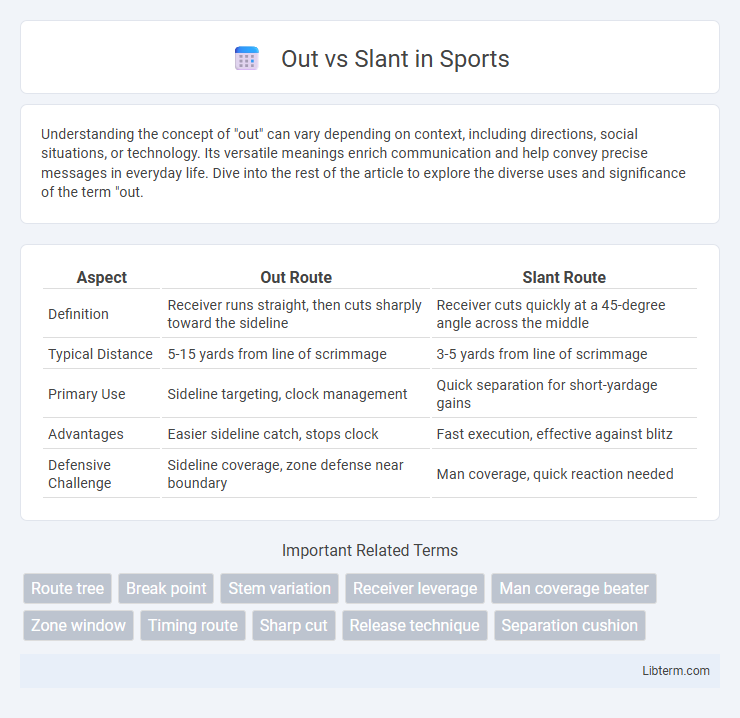Understanding the concept of "out" can vary depending on context, including directions, social situations, or technology. Its versatile meanings enrich communication and help convey precise messages in everyday life. Dive into the rest of the article to explore the diverse uses and significance of the term "out.
Table of Comparison
| Aspect | Out Route | Slant Route |
|---|---|---|
| Definition | Receiver runs straight, then cuts sharply toward the sideline | Receiver cuts quickly at a 45-degree angle across the middle |
| Typical Distance | 5-15 yards from line of scrimmage | 3-5 yards from line of scrimmage |
| Primary Use | Sideline targeting, clock management | Quick separation for short-yardage gains |
| Advantages | Easier sideline catch, stops clock | Fast execution, effective against blitz |
| Defensive Challenge | Sideline coverage, zone defense near boundary | Man coverage, quick reaction needed |
Out vs Slant: Key Differences
Out routes involve the receiver running toward the sideline at a sharp angle, typically 90 degrees, to quickly gain separation from the defender for a short to intermediate pass. Slant routes feature the receiver cutting diagonally across the field at a 45-degree angle, designed for quick timing and rapid yardage through congested defensive zones. The primary difference lies in the direction and timing: out routes prioritize sideline leverage and separation, while slants focus on speed and quick, inside route completion.
Understanding the Out Route
The Out route in football is a precise passing pattern where the receiver runs straight down the field before sharply cutting toward the sideline at a 90-degree angle, creating separation from the defender. This route is designed to exploit zones near the sidelines, providing quarterbacks with a quick and reliable target for intermediate gains. Understanding the Out route's timing and spacing enhances offensive efficiency by maximizing yards after the catch opportunities.
Breaking Down the Slant Route
The slant route is a quick-hitting pass pattern where the receiver takes about 3-5 steps diagonally across the field at a 45-degree angle, targeting the middle zone between linebackers and safeties. Compared to the out route, which involves a sharp 90-degree cut toward the sideline, the slant route provides faster, more direct path to exploit underneath coverage and create separation from defenders. Quarterbacks rely on precise timing and anticipation with the slant to capitalize on quick throws in short-to-intermediate passing situations.
Route Timing and Execution
Out routes require precise timing as the receiver breaks sharply toward the sideline, demanding quick release and accurate throws to maintain separation and avoid defensive coverage. Slant routes depend on rapid cuts at a 45-degree angle across the middle, emphasizing immediate route execution and swift quarterback decision-making to exploit short-yardage opportunities before defenders react. Both routes rely heavily on synchronization between the quarterback's throw and the receiver's break to maximize yardage and avoid turnovers.
Ideal Situations for the Out Route
The Out route excels in situations requiring quick, reliable gains on short to medium gains, particularly when the quarterback needs to evade pressure and deliver the ball swiftly to the sideline. Ideal scenarios include two-minute drills, third-and-short conversions, and when receivers line up near the boundary to exploit space for a clean sideline catch and immediate separation. This route minimizes risk of defensive coverage and maximizes yardage with controlled clock management and safe pass options.
When to Use the Slant Route
The slant route is ideal for quick, short-yardage plays where receivers cut sharply toward the middle of the field, exploiting openings in the defense's zone coverage. It is typically used to attack linebackers and safeties rapidly, taking advantage of their positioning and creating separation in congested areas. Slant routes excel in timing-based offenses and situations requiring fast reactions, such as third-and-short scenarios or quick pass plays to avoid heavy pass rush.
Defensive Challenges for Out vs Slant
Defending the Out route poses challenges such as timing and spatial awareness since defensive backs must quickly react to the sharp, lateral break toward the sideline, often risking exposure to sideline throws and screens. In contrast, defending the Slant route demands rapid recognition and immediate positioning to intercept the quick, diagonal cut across the middle, where linebackers and safeties face heightened risk of being outpaced or caught in traffic. Defensive coaches emphasize maintaining disciplined footwork and leveraging anticipation skills to disrupt route timing and minimize yards after catch on both route types.
Out vs Slant: Passing Windows
The Out route opens wider passing windows by pushing the receiver toward the sideline, allowing quarterbacks to release the ball quickly with clear separation from defenders. The Slant route creates tighter passing windows by cutting inside sharply, requiring precise timing and placement to exploit brief gaps in coverage. Mastery of Out versus Slant routes enhances quarterback accuracy and decision-making in varied defensive schemes.
Wide Receiver Skills Needed
Out and slant routes require wide receivers to master precise footwork and sharp cuts for quick separation. Out routes emphasize speed and timing to create space along the sideline, demanding strong hands for reliable catches under pressure. Slant routes rely on agility and route recognition to exploit defensive gaps, highlighting the receiver's ability to quickly accelerate after the catch.
Impact on Offensive Strategy
Out routes create quick, horizontal separation by targeting the sideline, enabling quarterbacks to exploit short-to-intermediate zones and maintain a brisk passing rhythm, which suits timing-based offenses. Slant routes emphasize rapid inside penetration toward the middle of the field, challenging linebackers and safeties while opening up run support opportunities and increasing quick yardage after the catch. Incorporating both routes strategically diversifies passing attack angles, complicating defensive reads and enhancing overall offensive adaptability.
Out Infographic

 libterm.com
libterm.com